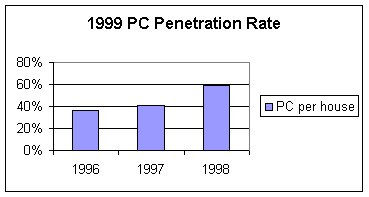
IT Usage
IT in Business
A large
number of companies, including the small and medium-size enterprises, are
adopting IT for their businesses. Although they face the challenges of
cost, security, and skilled manpower, the trend is for companies to
computerize and get online. Singapore
has one of the highest penetration rates for personal computers in
business. At least 75%
of businesses have at least one computer and of those, 81% of those
businesses have Internet access. [1]
IT
Spending
The
average spending on IT by each company for 1998 was S$54,514.
Companies are expected to increase spending by 5% each year.
Companies in the banking/finance, government, IT, and
telecommunications sectors are the largest spenders for IT. In contrast,
companies in the construction, education, retail/distribution, and
transportation sectors are the lowest spenders.[2]
IT Infrastructure
The level of IT sophistication is closely related to
the size of the company. Larger companies have higher local area network
usage. LAN connectivity in companies with more than 500 employees is close
to 100%. The LAN penetration in small companies is low as most of these
companies use stand-alone PCs.
Larger companies tend to use leased line access to
access the Internet. Close
to 80% of businesses continue to access the Internet through a dial-up
modem. Cable modem, a relatively new technology introduced a few years
ago, has an adoption rate of 3%.[3]
PC Penetration at Home
The PC penetration
rate in Singapore is on the rise. The
Infocomm Development Authority of Singapore (IDA) conducted a survey in
1999 and focused on PC penetration at home.
Key findings from the survey showed that Singapore is ahead of
countries including the United States, Australia, and Japan in terms of
household Personal Computer (PC) ownership and Internet penetration.
In 1999, 59% of households in Singapore own at least one computer
compared to 36% in 1996. See
Figure 1 below. [4]

Figure
1
The rapid increase in
PC penetration can be attributed to the government's efforts in promoting
computer usage among the general public, as well as the emphasis on IT
usage in the school curriculum with the implementation of the IT Master
plan in education. According
to the IDA report, Singapore's ownership rate of home computers was higher
than the following countries: Japan (43%, Nomura Research Institute, May
1999), Australia (47%, Australian Bureau of Statistics, May 1999) and
United States (54%, Arbitron New Media, 1999.) See figure 2 below.

Home Internet Penetration
Home Internet access
has also grown rapidly since the availability of public access in 1994.
In 1996, only 9.0% of Singapore households had Internet access.
In 1999, it jumped to 42% of all households.
This compared favorably with the rates in Australia (22%), Japan
(13%) and the U.S. (40%). The
total number of Singapore home Internet users in 1999 was estimated at
764,680, a significant increase from 114,368 in 1996.[6]
The rapid increase
was attributed to a variety of factors:
- competitive
Internet subscription fees offered by the local Internet Access
Service Providers (IASPs),
- free
accounts given by schools or low/subsidized subscription rates, and
- high
rate of home computer ownership.
Use of the Internet
Home users with
Internet access used the Internet most frequently for email/chat (87%),
information retrieval (70%), news (25%), web applications (20%) and
on-line games/movie-watching (17%). Use of the Internet for e-commerce
activities such as on-line shopping and on-line government transactions
was still at the
early adoption stage. On-line shopping attracted 8.0% of home Internet users. The most popular items bought were books and stationery, and the most popular payment mode was the credit card. The survey also revealed that 14% of the home Internet users used the Internet to access on-line government transactions. The most common transaction was the submission of Income Tax Returns, followed by requests for pension fund statements.[7]
Demographics
In terms of the
users' profile, 80% of the households with personal computers have
multiple users. More than half of internet users are male (55%), below 30
years old (59%) and have a tertiary education (53%).
Barriers and
Motivations
For those
Singaporeans who do not own a PC, the main reason they report is lack of
perceived need. This was the same reason offered by those without home
Internet access. Households
without Internet access cited three motivations that would get them to
subscribe to Internet access services and include:
§
cheaper subscription/access
fees
§
need to surf for information
§
children’s need to use the
Internet
Internet Service
Providers:
The Tele- communications Authority of Singapore (TAS) regulates ISPs. They lifted all restrictions on the ISP market in 2000 which raises the of ISPs to six. Below is a list the ISPs in Singapore.
COMPANY |
URL |
|
Pacificnet |
http://www2.pacfusion.com/sg/ |
|
Singnet |
|
|
StarHub |
|
|
Mysingtel |
http://www.uu.net/sg/index.xml |
|
UUNet (MCI
Worldcom) |
http://www.uu.net/sg/ |
|
Cable
& Wireless Network Services
(Singapore) Pte Ltd |
(http://www.cwasia.net.sg) |
Mobile
Phone
Singapore has a
fairly high penetration rate for mobile phones.
Forty five percent of Singaporeans own a mobile phone.
This is behind the penetration rate of Honk Kong - with a 59.43
percent usage rate - but was higher than Japan's 42.97 percent [8]
Singapore,
known for its strict anti-littering and anti-chewing gum laws, now plans
to jail motorists who hold mobile phones to their ears while driving. They
face a six-month jail term for a first offense or a S$1,000 ($588 U.S.)
fine, or both, and a driving ban, a police spokesman said. A second
offence would double the fine and jail term. [9]
[1] The Infocomm Development
Authority of Singapore (IDA), Information Communications Technology (ICT)
Usage Survey 1999
[2] ibid
[3] ZDNetAsia, January 23, 1001,
Singapore PC shipments increase 2 percent
[4] Tradeport, INFORMATION TECH HOUSEHOLD SURVEY, Febrauary
9, 2000
[5] The Infocomm Development Authority
of Singapore (IDA), Information Communications Technology (ICT) Usage
Survey 1999
[6] ibid
[7] ibid
[8] Importers and Exporters Association of Taipei
[9] ZDNetAsia, June 25, 2000, Use Cell Phone, go to jail, in Singapore